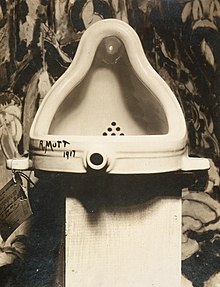New York Dada
The primary artists were Marcel Duchamp, Francis Picabia, Man Ray, Beatrice Wood, Louise Norton, Elsa von Freytag-Loringhoven, Juliette Roche Gleizes, and Jean Crotti.
Because of this groups philosophical orientation (with an anti-nationalistic, anti-war, and anti-bourgeois attitude featuring prominently), techniques of art production (from varieties of Cubism to collage as well as ready-mades), critique of prior forms of art (in particular those forms identified with classical conceptions of mimetic representation, as well as those deemed tainted by affiliation with aristocratic or bourgeois values and or aristocratic or bourgeois patronage), self-pronounced allegiances (with each other as well as other avant-garde artists), and relation to other similar groups in Europe, they are referred to as Dada.
[2]Beginning with a showing of the work of Picabia at gallery 291 (if not the armory show in 1913 where a few of the works of Picabia and Duchamp set the stage for future endeavors), owned and operated by renowned and historically influential photographer Alfred Stieglitz, this group began to take shape[3][page needed] Coupled with Stieglitz’s gallery, the patronage, enthusiasm, and intellectual support of the Arsenbergs provided the economic conditions of possibility for the Dada artists to exist in New York at that time.
Stieglitz first made contact with the (soon to be) Dadaists at the notorious Armory show of 1913 where Picabia and Duchamp exhibited paintings that caused an uproar in the New York art scene.
Duchamp's Nude Descending a Staircase and Picabia's Dances at the Spring featured prominently at the show and caught the eye of Stieglitz, they proved to be just a taste of what was to come.
According to Richter, "Stieglitz was a man of lively perception, intensely interested in everything that was new and revolutionary,"[1] undoubtedly this demeanor and demand to seek new forms of artistic expression made him a perfect match for the European's coming ashore.
According to Hans Richter, Picabia was driven by "an absolute lack of respect for all values, a freedom from all social and moral constraints, a compulsive urge to destroy everything that had hitherto been given the name of art.
"[9] As with Duchamp, Picabia was escaping the first World War, but he was also attempting to find an avenue for his artistic philosophy that utilized the achievements of early modern art in France while simultaneously distancing himself from them.
Beginning with his "Nude Descending a Staircase" which was exhibited at the famous Armory show of 1913, his work became well known and controversial across the New York, as well as American in general, art scene.
His personality was equally intoxicating as his art; according to Richter, "Duchamp's attitude is that life is a melancholy joke, an indecipherable non-sense, not worth the trouble of investigating.
To his superior intelligence the total absurdity of life, the contingent nature of a world denuded of all values, are logical consequences of Descartes' Cogito ergo sum.





